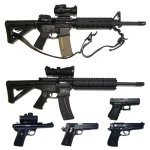LemonadeGrenade
Member
- Joined
- Feb 2, 2012
- Messages
- 24
- Reaction score
- 2
Recently received a hand-me-down red dot site from a friend. Up until now I've just been using the irons and have been very happy with them. I've never used a red dot optic before and wanted to know if people had different opinions on how far forward or rearward on the rail it belongs.
Is it purely a matter of preference and comfort? Does it depend on the distance or style of shooting? Any advice or opinions are appreciated.
Thanks all.
Is it purely a matter of preference and comfort? Does it depend on the distance or style of shooting? Any advice or opinions are appreciated.
Thanks all.

